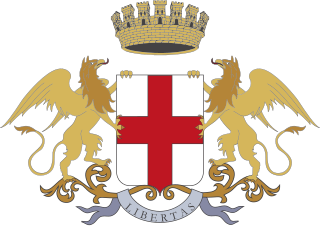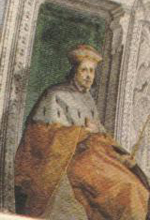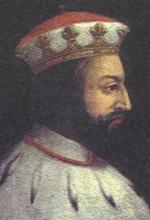The mandate
The dogeship of Domenico was dominated by the Genoese bid to dispute the sole control of the Kingdom of Cyprus. The Genoese fleet conquered the island in 1372 under the command of the brother of the doge, Pietro Fregoso and even managed to storm the capital city of Famagosta. While the Mediterranean sea was alive with the conflict between commercial rivals, Genoa also had to contend with the restlessness of the Ligurian countryside and North African pirates.
In 1378, while he was fighting off the mercenary company known as the Star, the popular party withdrew its support to the doge and called for Antoniotto Adorno. On June 17, Domenico was deposited and banished from the city.

The Doge of Genoa was the ruler of the Republic of Genoa, a city-state and soon afterwards a maritime republic, from 1339 until the state's extinction in 1797. Originally elected for life, after 1528 the Doges were elected for terms of two years. In actuality, the Republic was an oligarchy ruled by a small group of merchant families, from whom the doges were selected.
Giano II di Campofregoso (1455–1525) was the 43rd Doge of Genoa, ruling from 29 June 1512 to 25 May 1513.

Giano I di Campofregoso was the 31st Doge of the Republic of Genoa.

Antoniotto II Adorno was Doge of the Republic of Genoa from 1522 to 1527. Adorno was the last of the Genoese doges elected for life.

Antoniotto di Montaldo was the doge of Genoa on two occasions between 1392 and 1394.

Pietro Campofregoso was Doge of Genoa from 1450 to 1458.
Agostino Fregoso was an Italian condottiero belonging to the Fregoso family of Genoa. He was also lord of Sant'Agata Feltria.

Paolo di Campofregoso was an Italian Catholic archbishop who was three times doge of Genoa.

The Most Serene Prince Antoniotto Adorno was the 6th doge of the Republic of Genoa and rose four times to this supposedly lifelong position, making him the person most often elected to the Doge office in the history of the republic.

Nicolò Guarco was a Genoese statesman who became the 7th doge of the Republic of Genoa and led the Republic through the War of Chioggia against Venice.

Ottaviano Fregoso was the Doge of the Republic of Genoa.

Giacomo Fregoso or Campofregoso (1340–1420) was a statesman who became the 10th doge of Genoa.

Pietro Fregoso was a statesman who became the 13th Doge of Genoa.

Giorgio Adorno was a statesman who became doge of the Republic of Genoa for two years. His father was Adornino Adorno and his mother Nicolosia della Rocca and his brother, Antoniotto, was elected four times as doge of the Republic. He was born c. 1350 but little is known about his youth except that he married Pietrina Montaldo, daughter of the doge Leonardo Montaldo. With her he had nine children, including the future doge Raffaele Adorno.

The Fregoso or di Campofregoso were a noble family of the Republic of Genoa and Liguria in general, divided into numerous branches, whose members distinguished themselves on numerous historical occasions; many of them held the position of Doge of Genoa, some were also lords of Sarzana; others finally held various fiefdoms, lands and titles along the arc of the Ligurian Apennines, such as the county of Sant'Agata Feltria which was owned by Agostino Fregoso. The Fregoso family monopolized the Dogate's lifetime office, becoming the dynasty who produced the highest number of doges in the history of the Republic.

Barnaba Guano was the 23rd Doge of the Republic of Genoa.

Barnaba Adorno was the 30th Doge of the Republic of Genoa.

Spinetta Fregoso was the 35th Doge of the Republic of Genoa.

Battista Fregoso was the 27th Doge of the Republic of Genoa. His leadership lasted only one day.

Prospero Adorno was the 34th Doge of the Republic of Genoa. Between 1477 and 1478 he was appointed Genoese governor for Gian Galeazzo Maria Sforza, after the submission of the Republic to the Duchy of Milan.
This page is based on this
Wikipedia article Text is available under the
CC BY-SA 4.0 license; additional terms may apply.
Images, videos and audio are available under their respective licenses.










